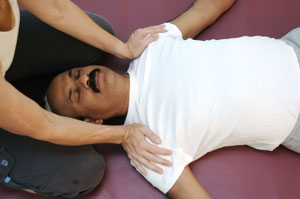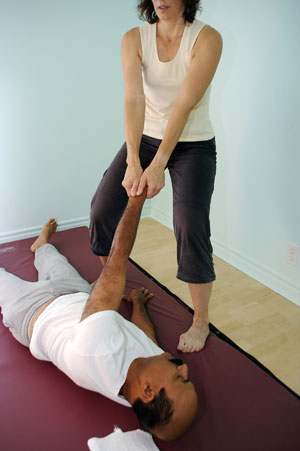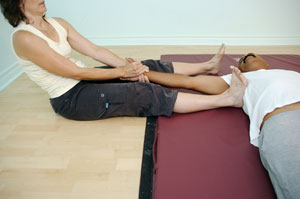
Features
Practice
Technique
What is passive stretch massage?
In my last article I described how i discovered Passive Stretch Massage. In this article I will describe what Passive Stretch Massage is; its risks and benefits; its indications and contraindications; and required space and equipment.
September 29, 2009 By Piroska Kennedy RMT

In my last article I described how i discovered Passive Stretch Massage. In this article I will describe what Passive Stretch Massage is; its risks and benefits; its indications and contraindications; and required space and equipment.
A full-body Passive Stretch Massage session is comprised of; the assessment and relaxation phase, the tractioning of the legs, arms and head. (Resulting in the tractioning of the entire vertebral column.)
As with any other massage modality, Passive Stretch Massage should be designed to meet the goal of each client’s individual and specific needs. PSM can be applied with relaxation and assessment as a lower or upper body treatment, or parts of it can be included into a massage therapy treatment, to mobilize a joint(s) if required.
The client is first positioned supine on the mat. The therapist then instructs them in proper abdominal breathing. I simply tell the client to slowly breath in through their nose, allowing their stomach to fully rise, and then slowly let the air out through their mouth until their stomach has fully dropped.
This part of the treatment is vital if you wish to provide maximum benefit. I often take a few minutes and inform the client of the benefits of abdominal breathing during the Passive Stretch Massage session.
In review: one of the major benefits of abdominal breathing is that it decreases the firing of the Sympathetic Nervous System, which in turn allows for an increase of activity in the Parasympathetic Nervous System. This process has many major effects on the body; it reduces stress, muscle tone, heart rate, and blood pressure, all of which assist in breaking the pain cycle.
Abdominal breathing also considerably increases circulation of oxygen and nutrients to muscle fibres, and induces relaxation of muscles allowing for elongation. These last two benefits are crucial for a safe and effective Passive Stretch Massage treatment.
Once the client is comfortable with abdominal breathing the therapist may begin with their assessment/relaxation phase of the treatment. With the use of a sequence of gentle muscle squeezing, kneading, rocking, rolling, and shaking techniques, starting at the feet and working up to the hips (one leg at a time), the therapist not only assists the client in attaining a deeper state of relaxation, but is also observing how each leg is moving and how the movements are undulating up the entire vertebral column. Similar techniques for relaxation and assessment are performed along each arm. The therapist can finish this part of the treatment with rhythmic mobilizations of the cervical spine.
As the client remains fully relaxed using abdominal breathing, the therapist can begin slow and gentle tractioning of the client’s limbs in co-ordination with the client’s rhythmic breathing pattern. As the client inhales the therapist takes hold of the first limb and places it into the first tractioning position. As the client begins to exhale the therapist applies a gentle traction to the limb. As the client begins to inhale again, the therapist holds the limb or allows for a very slight release of the limb.
On the clients second exhalation the therapist slowly and gently increases the amount of traction applied to the limb. The therapist continues with this slow and gradual increase in traction until a full stretch has been achieved. This usually consists of 3 to 6 tractioning cycles depending on how relaxed the client is and on the amount of restriction they have in their fascia, muscles and joints. The stretch is then slowly released and the therapist applies the same traction at the same angle to the second limb.
All the tractioning and stretching techniques are to be applied one at a time, alternating back and forth from one leg or arm to the other.
 Risks of Passive Stretch Massage
Risks of Passive Stretch Massage
When PSM is indicated for a particular client, there are few risks to be concerned with. The most common is the potential discomfort that can occur during a treatment, caused by the therapists’ grip, i.e. when tractioning the leg, the therapist must have a firm grip of the calcaneus and dorsum of the foot. The client may feel discomfort from the pressure, or friction on the skin under the therapists’ hands. Adjusting the therapist’s grip quickly resolves this issue.
The second most common risk is for the client to feel a fascial or neural stretch in a specific area or along the full length of the limb being stretched. Neither of these is harmful to the client. The traction may actually assist in the release of the restriction. Once the client informs you of the presents of such discomfort, the length of the held traction will dependent on the clients’ level of comfort.
The last risk to make the client aware of is, the possibility of pain in or around a joint. In such a case it is advised that the therapist slowly release the traction, change the grip, and/or reposition the limb and proceed with the treatment. If the pain persists in the same joint area, the therapist should stop and move to the next limb. After the session it would be recommended to schedule another appointment to do a complete assessment of the affected joint.
Benefits of Passive Stretch Massage
I’m sure that as some of you read the above description of what Passive Stretch Massage is, you began to visualize and imagine which body structures are affected and how. I practiced this modality for three years before studying massage therapy, and it wasn’t until I treated Bruce, my anatomy and physiology instructor and received his feedback, that I realized the degree of benefits that this modality has to offer.
Passive Stretch Massage has a positive affect on every system of the body. It directly affects the intequmentay, skeletal, muscular, and nervous systems. And it has an indirect affect on the endocrine, cardiovascular, lymphatic, respiratory, digestive and urinary systems. Today I will focus on some of the more important effects that it has on the fascia, muscular and skeletal systems.
Fascia & How Passive Stretch Massage Affects it
Fascia is a fibrous connective tissue, of varying thickness and strength, found throughout the entire body (1).
Superficial fascia is found immediately beneath the skin over almost the entire surface of the body. This superficial fascia is interconnected with the deeper aponeruotic fascia, which is a denser, tighter, inelastic, unyielding fibrous membrane which surrounds and compartmentalizes every muscle fiber, muscle group, bone and organ.
A third layer of fascia, subserous fascia, is described by Rattray and Ludwig (2), as being a loose areolar tissue that covers the viscera, supporting the organs and providing lubrication so that they may slide against each other.
We are supported, bound together, and held upright by our fascia, without it we would be but a puddle of liquid in a bag of bones on the floor. Fascia requires movement, warmth and adequate hydration to remain healthy. The state of our fascia determines the state of our body as we age.
The shorter and tighter our fascia is, the tighter, more compressed and restricted our body becomes.
It is important to keep in mind that most of the body’s fascia houses adipose tissue, vascular structures and nerve receptors. You can imagine what happens to these tissues and structures when the fascia is shortened, tightened, and hardened around them. The application of Passive Stretch Massage helps to lengthen the fascia increasing circulation to and through it. The release of the fascia’s tight grip on muscular, neural and vascular structures creates an increase in the client’s range of motion as well as a decrease in discomfort or pain.
 What Happens to our Muscles Over Time?
What Happens to our Muscles Over Time?
As we age, we develop various degrees of muscle imbalance in weight bearing and postural muscles. This leads to a gradual shortening of the muscle fibers and surrounding fascia. Over time, this will result in the compression of arteries, veins, nerves and joints, and deterioration of joint surfaces due to joint misalignment.
When a muscle is held in one position without moving, the fuel demand of the muscle does not equal the actual flow it receives.
This condition is called static muscle loading (3) and is caused by long periods of muscle contraction or shortening from improper posture.
The reduced blood flow causes less oxygen or fuel supply to the muscles. As a result, metabolic waste products, such as lactic acid, are created and muscular fatigue occurs along with the shortening of the fascia followed by the compression of joints.
This leads to various types of pain, such as headaches, shoulder stiffness, neck and low back pain, and even numbness and tingling down a limb. These complaints are presented by clients suffering from repetitive stress injuries at stationary jobs (sitting, standing, bending and/or lifting occupations) or from a build up of emotional stress.
What Happens To Muscle During Stretch?
When a muscle is stretched in a slow and gentle fashion, there is an increase in its tension. In a matter of milliseconds, the spinal cord reflexively tells the muscle to shorten in order to protect the muscle from being over stretched. It takes 6-10 seconds for the brain and spinal cord to perceive that the stretch is safe. At this point, the mild pulling sensation experienced, subsides. It is in the next 20-24 seconds that the stretch causes its beneficial effect (4).
PSM tractioning places a gradually increasing load on the muscles and structures surrounding the joint. Each traction is held for well over 30 seconds causing the neuro-pathways to allow for greater elongation of the muscles and fascia therefore resulting in the release of tissues involved. The results of this process have a tremendous affect on the client’s physical and psychological state.
Physical Changes Occurs at two levels
First level – the client is very well aware of: Relaxation and unwinding of muscle tension, the decompression of joints, increased range of movement without restrictions and pain, improved posture, physical alignment, balance, coordination, and agility. The muscles, tendons, ligaments and joint capsules of the body all stretch to varying degrees (5. Chrissie Gallagher-Mundy), this in turn gives an impression of the whole body feeling elongated, extended and lifted.
Second level – occurs deep within the body with no conscious awareness: Decreased blood pressure, increased circulation of oxygen and nutrients, quicker removal of waste products, reduced inflammation, reduced pressure on joint cartilage and spinal discs, and reduced stress on the nervous system.
Psychological Changes
Whatever affects the body will also have an impact on the mind. On a psychological level, clients will feel calm, relaxed, clear minded, mentally energized, they will feel like there is a special connection between their body and mind, all of this leading to an immense overall sense of well-being.
I believe that this feeling of euphoria, as some have described it, comes from the results of entrainment. Entrainment can be defined as the tendency for two oscillating bodies to lock into phase so that they vibrate in harmony, or as a synchronization of two or more rhythmic cycles. A simple example that most of you will be able to relate to is musical entrainment which has the potential to resonate with the listener’s feelings, transform negativity into positivity, or promote a state of liveliness or serenity.
In Passive Stretch Massage, entrainment is gradually induced as the client breaths abdominally while listening to relaxing music as the therapist slowly
and rhythmically applies gentle muscle squeezing, kneading, rocking, rolling and shaking techniques to the limbs. The clients breathing, heartbeat, and brain waves are gradually synchronized in a three-way entrainment in which the system with the greater frequency slows down, and the others accelerate
until they all vibrate at the same frequency.
Indications and Contra-Indications of Passive Stretch Massage
Passive Stretch Massage is very beneficial in the rehabilitation of such conditions as whiplash (for which the treatment is easily applied on a massage table rather than on the mat), thoracic outlet syndrome, headaches, stress, reduced range of motion at any joint, degenerative disc disorder, SI joint dysfunctions, sciatic problems, and non-specific low pack pain. It also has a considerable positive effect on all soft tissues and joint structures especially the fascia, muscles, muscle spindles, tendons, GTO, ligaments, joints and joint capsules.
As with every massage therapy modality there are some contra-indications to Passive Stretch Massage. Pregnancy, dislocations and subluxations, bony changes (fusions, bone spurs), advanced arthritis, fractures, acute injuries, long term diabetes, osteoporosis, hyper-mobile joints, nerve damage, and stroke. These are covered in more detail in the course.
Space and Equipment
As mentioned earlier Passive Stretch Massage is performed on a mat on the floor, therefore a comfortable mat is needed. I use a 2-inch thick, 7-foot-long and 4-foot-wide mat. The size of the room used to provide the Passive Stretch Massage needs to be twice the size needed for a table massage, approximately 10 feet by 12 feet. Other necessary items are; a hand towel (to control slippage of grip), two small pillows, for the client’s head and knees, and a blanket to ensure the client’s warmth.
INFORMATION:
For more information contact Piroska Kennedy, RMT at: piroska@fabyourlife.com or piroska.kennedy@hotmail.com
References:
1. Gray, Henry F.R.S. (1974). Gray’s Anatomy: 296-297
2. Rattray, Fiona, Ludwig, Linda (2000). Clinical Massage Therapy, Understanding, assessing ad Treating Over 70 conditions: 45
3. Oswald Christopher A., Bacso Stanley N. (2002). Stretching for Fitness, Health & Performance: 11,
4. Oswald Christopher A., Bacso Stanley N. (2002). Stretching for Fitness, Health & Performance: 8
5. Gallagher-Mundy Chrissie (2003). Stretch Plan, for Everyday Health, Fitness and Sport: 10
Print this page